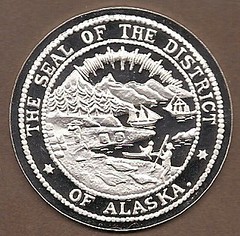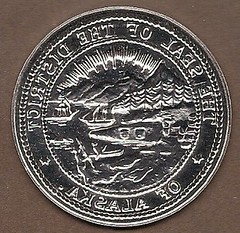
PREV ARTICLE
NEXT ARTICLE
FULL ISSUE
PREV FULL ISSUE
VOCABULARY WORD: CLICHÉDick Hanscom writes: The other day on eBay I saw a term that I have not seen before – cliché. It is not in "The Macmillan Encyclopedic Dictionary of Numismatics by Doty, or International Encyclopaedic Dictionary of Numismatics by Carlton.
Below are the images and relevant text from the lot description.
-Editor


The District of Alaska was the governmental designation for Alaska from May 17, 1884 to August 24, 1912, when it became Alaska Territory. Previously it had been known as the Department of Alaska. Embossed-like striking referred to as a cliché. To view the eBay lot, see: District of Alaska (Pre-Territory) Cliché Silver Medall (cgi.ebay.com/ws/eBayISAPI.dll?ViewItem&item=370278892699)
Clichés are unusual, and I have heard the term before. But for a detailed answer, I knew who to ask - E-Sylum regular Dick Johnson, who submitted the following explanation of the term. Thanks!
-Editor
The example E-Sylum reader Dick Hanscom writes about is a misuse of the term cliché. This is understandable since it was used by an eBay seller, often the most misinformed people on earth. A cliché is a one-sided diestruck item, but it is different from a uniface item. It is a special form of a diestruck item. This is the first I have heard of an embossed impression -- or its die -- being called a cliché. Neither of which is correct. The eBay illustration is a positive and negative of the state's seal. A negative embossing die would make a positive impression on paper, thin metal foil or such. It has nothing to do with the making of a true cliché in the numismatic sense. I wrote on just this subject earlier this year in Medal Collectors of America newsletter in an article titled "Cliché versus Uniface Medal--What's the Difference?" I will extract some data from that article for this reply. Clichés are made with two thin blanks struck in a press at the same time with a mated pair of dies. The original purpose was to make these as a first strike to give to the artist -- engraver or medallist -- for his initial examination. These are a pair of proof impressions for the artist's approval. These initial strikes became desirable items, however, that museums requested them for the distinct purpose of being able to display the two designs side-by-side, both obverse and reverse next to each other. Actually clichés could be struck at any time the dies were still correctly positioned in the press, not just initially. When properly made true clichés will exhibit suction marks or ghosting on the two interface surfaces of the struck pieces. The strongest device -- usually with the highest point of the design -- will form a sunken area on the back side of each blank where metal is drawn from the mass of the blank to fill the incuse area of that die. On the obverse, for example, this is usually a portrait that forms a sunken impression on its adjacent blank. This indistinct sunken surface sometimes is formed with a wavy surface as the metal flowed from the force of the die. There is no transfer of the suction movement to the opposite blank. Each blank takes the image of its die alone. The boundary formed between the two blanks is immovable. The suction does not cross over to the second blank. Since medals are usually multiple struck to bring up the full relief that the artist intended, clichés have to go back on the press just like a solid medal for a second or subsequent blow. It is a problem for the pressman, then, to position both blanks to the correct orientation every time. Keying clichés. The solution was to key the two blanks to each other. This is done by the pressman who picks up a letter or figure punch -- any punch will do -- about one-quarter inch tall and tap the punch into one of the blanks in several locations. I have seen these punch marks in three or four places located at the corners of an imaginary triangle or square. With the first blow on the press these indentations cause metal from the opposite blank to flow into these impressions. For the second or subsequent blow it is then an easy task for the pressman to orientate the two blanks to lock the two blanks in tandem by this keying and rest the two in position on the lower die to be struck again. The correct obverse / reverse alignment is achieved. Therefore a diagnostic of a cliché is the suction or ghosting on the back of a real cliché and three or four possible punch marks. It is an advantage to have the two matching clichés; but it often happens these become separated in time. The term cliché comes from the sound the press made when striking these (or from striking a solid piece, as a matter of fact). As presses became heavier, bigger and more powerful the sound became more of a KER-PLUNK instead of a KLE-SHAY.
On the other hand, uniface medals, have a smooth flat back. These are struck with a smooth-faced jack die mated with the die that forms the obverse with the design. Uniface medals are often utilized by attaching to something (book cover, furniture, and such). Frequently a maker's mark, hallmark or other lettering is found punched on the back.
The Numismatic Bibliomania Society is a non-profit organization promoting numismatic literature. See our web site at coinbooks.org. To submit items for publication in The E-Sylum, write to the Editor at this address: whomren@gmail.com To subscribe go to: https://my.binhost.com/lists/listinfo/esylum All Rights Reserved. NBS Home Page Contact the NBS webmaster 
|